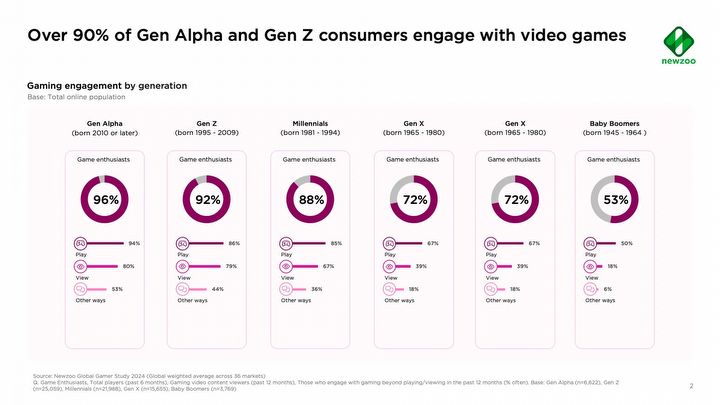
As a seasoned gamer with decades of experience under my belt, it’s fascinating to see how video games have transcended generational boundaries and become a universal language of entertainment. Growing up, I never imagined that grandparents would be exploring virtual worlds or battling it out in Fortnite arenas!
It’s no longer just kids and teens who are into video games, as suggested by the latest Global Gamer Study titled “How Today’s Consumers Interact with Games.” In this online survey involving 73,000 participants, it was found that: Approximately 85% of internet users can be classified as avid gamers, and a staggering 80% of respondents are currently engaged in playing games. (Source: GamesIndustry.biz)
Intergenerational “enthusiasts”
According to data from Newzoo, approximately half of individuals born between 1945 and 1964 are actively involved or connected with video games. This “involvement” can encompass playing the games themselves, as well as watching related content, discussing them with others, or participating in activities linked to video games over a 12-month period. It’s important to note that at least half of these individuals have independently played some kind of game at least once per year.
It’s no wonder that as the age of the participants drops, we find a higher percentage of individuals from different generations involved in gaming. For instance, in the 1965-1974 age bracket, about 71% had some form of interactive engagement with games, while an impressive 96% of those born after 2010 are avid gamers, playing at least once over the past year. Notably, this youngest group dedicates approximately 5.2 hours per week to gaming, making it their most popular activity and even outranking social media in terms of time spent on it.

Mobile games, console and PC expenses
The report also mentions the most popular titles, although the category “adventure” is perhaps a bit too broad in the three youngest generations. The respondents gave examples of games such as Minecraft, GTA, Call of Duty, and Fortnite. In the case of older generations, logic games were more often mentioned.
Regardless of the widespread popularity of mobile games, it’s PC and console gamers who tend to spend the most money. In fact, a study’s findings suggest that these players are more inclined than their mobile counterparts to invest in various game titles, expansions, microtransactions, and other in-game purchases.
Additionally, these individuals tend to show a greater readiness than typical mobile game enthusiasts to make an upfront payment, particularly for high-end or premium games.
Giants of games and seekers of the new
Moreover, data from Newzoo supports previous reports from January, indicating that top-selling games garner the highest levels of attention and revenue for publishers.
80% of gaming hours in 2023 were dedicated to just 66 games on Steam, despite a massive 14.5 thousand new releases. However, it’s worth noting that 31% of console and PC gamers tend to delve into novel or popular titles, while 38% focus predominantly on the visual appeal.
It might be astonishing to learn that the majority of these “innovation enthusiasts” aren’t primarily from the United States, Japan, or Europe, but rather hail from China, India, Vietnam, Saudi Arabia, and Egypt (comprising approximately 35% of these players). Japan trails significantly behind with only about 15%.
Read More
- Finding Resources in Palworld: Tips from the Community
- The Last Epoch Dilemma: Confronting the Gold Dupe Crisis
- UFO PREDICTION. UFO cryptocurrency
- BONE PREDICTION. BONE cryptocurrency
- OKB PREDICTION. OKB cryptocurrency
- Michelle Yeoh Will Not Appear in ‘Avatar 3,’ Says James Cameron: ‘She’s in 4 and 5’
- EUR HKD PREDICTION
- Celebrating Hu Tao’s Birthday in Genshin Impact
- Helldivers: Notable Changes and Community Reactions
- Last Epoch: Why Keystroke Registration Issues Are Frustrating Players
2024-09-03 09:02